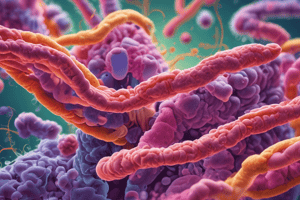Podcast
Questions and Answers
What is the purpose of using reducing agents in anaerobic bacterial cultures?
What is the purpose of using reducing agents in anaerobic bacterial cultures?
- To enhance the growth of microaerophiles
- To remove oxygen from the media (correct)
- To promote the growth of aerobes
- To inhibit the growth of facultative anaerobes
Which of the following bacteria is an obligate aerobe?
Which of the following bacteria is an obligate aerobe?
- Pseudomonas aeruginosa (correct)
- Bacillus subtilis
- Staphylococcus epidermidis
- Clostridium perfringens
What is the purpose of an anaerobic jar with Gaspak?
What is the purpose of an anaerobic jar with Gaspak?
- To isolate obligate anaerobes
- To culture microaerobic bacteria
- To remove oxygen from the media (correct)
- To provide oxygen for aerobic bacteria
Which media is commonly used for the primary cultivation of anaerobic bacteria from clinical specimens?
Which media is commonly used for the primary cultivation of anaerobic bacteria from clinical specimens?
What is the Gram stain reaction of Clostridium perfringens?
What is the Gram stain reaction of Clostridium perfringens?
What is the classification of Staphylococcus epidermidis based on oxygen requirements?
What is the classification of Staphylococcus epidermidis based on oxygen requirements?
Which of the following anaerobic bacteria is typically found in the human colon?
Which of the following anaerobic bacteria is typically found in the human colon?
Which Clostridium species is associated with food poisoning?
Which Clostridium species is associated with food poisoning?
What is the characteristic hemolytic pattern of Clostridium perfringens on Blood Agar?
What is the characteristic hemolytic pattern of Clostridium perfringens on Blood Agar?
What is the disease caused by Clostridium tetani?
What is the disease caused by Clostridium tetani?
Which of the following is a characteristic of Clostridium perfringens?
Which of the following is a characteristic of Clostridium perfringens?
What is the term for the disease caused by Clostridium perfringens, which is characterized by the production of enzymes that destroy host cells?
What is the term for the disease caused by Clostridium perfringens, which is characterized by the production of enzymes that destroy host cells?
What is the result of the action of the neurotoxin produced by Clostridium tetani?
What is the result of the action of the neurotoxin produced by Clostridium tetani?
What is the common route of transmission of Clostridium difficile?
What is the common route of transmission of Clostridium difficile?
What is the condition characterized by a lack of intestinal microbiota, making it possible for Clostridium botulinum to germinate in the gut?
What is the condition characterized by a lack of intestinal microbiota, making it possible for Clostridium botulinum to germinate in the gut?
What is the combination of vaccines usually given to children to protect against tetanus?
What is the combination of vaccines usually given to children to protect against tetanus?
What is the disease caused by Clostridium botulinum, characterized by rapidly progressing paralysis?
What is the disease caused by Clostridium botulinum, characterized by rapidly progressing paralysis?
What is the condition that allows Clostridium difficile to proliferate in the large intestine?
What is the condition that allows Clostridium difficile to proliferate in the large intestine?
Study Notes
Clostridium: Clinical Significance and Laboratory Diagnosis
- Clostridium species are Gram-positive, endospore-forming anaerobic bacilli that are commonly found in the intestinal tract of humans and animals, as well as in soil.
- Four Clostridium species are important in human disease: C. perfringens, C. tetani, C. botulinum, and C. difficile.
Methods to Culture Anaerobes
- Anaerobes require a proper atmosphere to grow, and specimens from patients must be incubated in a suitable environment.
- Factors affecting bacterial growth include oxygen availability, with aerobes, anaerobes, microaerophiles, facultative anaerobes, and aerotolerant anaerobes having different oxygen requirements.
Media for Anaerobe Culture
- Cooked meat broth contains reducing agents and nutrients, making it suitable for the primary cultivation of anaerobic bacteria from clinical specimens.
- Thioglycollate broth contains sodium thioglycolate and cystine, which remove oxygen from the media, allowing anaerobes to grow.
- Anaerobic jars with Gaspak and anaerobic plastic pouches can be used to create an oxygen-free environment for anaerobe growth.
Clostridium Species
- C. perfringens is a Gram-positive, endospore-forming anaerobic bacillus that causes food poisoning and "gas gangrene".
- C. tetani causes tetanus, a disease characterized by permanent muscle contraction, and can be prevented with a toxoid vaccine.
- C. botulinum causes botulism, a disease with two forms: foodborne botulism and infant botulism, which can lead to rapidly progressing paralysis.
- C. difficile causes pseudomembranous colitis, a life-threatening disease, and is the most common nosocomial cause of diarrhea.
Laboratory Diagnosis
- Gram stain and endospore stain can be used to identify Clostridium species.
- Hemolytic patterns on blood agar can be used to differentiate between Clostridium species.
Studying That Suits You
Use AI to generate personalized quizzes and flashcards to suit your learning preferences.
Description
This quiz covers the clinical significance of Clostridium, Gram stain reaction and morphology, and methods to culture anaerobes. It also explores factors affecting bacterial growth, including oxygen requirements and different types of anaerobes.




